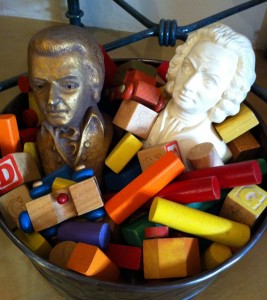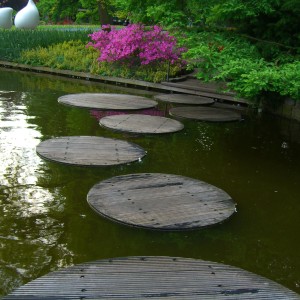Playing With Wolfgang: Stories, Images, Colors, & Characters
 “What is going on in this passage?”, asked my new teacher. I responded by giving him what I thought was a crackerjack harmonic analysis. “Yes, he said but why?” I said some things about building and releasing tension mixed with a bit about the composer’s life and sonata form. “But what is this piece about and how are you going to make that happen in sound?”, he asked.
“What is going on in this passage?”, asked my new teacher. I responded by giving him what I thought was a crackerjack harmonic analysis. “Yes, he said but why?” I said some things about building and releasing tension mixed with a bit about the composer’s life and sonata form. “But what is this piece about and how are you going to make that happen in sound?”, he asked.
Make it happen? Me, myself and I? I was in a no man’s land. Lost. It seemed to me that none of what my previous teachers had given me was of any help here. The piano and I spent a rather frustrated year together.
When I was an undergrad, my teacher had a lot of work to do just to get me understanding classical style, phrasing, technique… Well everything really. After a lot of modeling and mentoring on his part, a piece musically seemed to flow from me quite naturally. I needed the coaching. Still, there were passages that never really came together for me and I felt that but didn’t know what was missing.
My next teacher gave me a system for learning and memorizing music including, a mathematical metronome calculation starting 30 tempos under final tempo, 2-4 measure sections, and odd and even sections. I were expected to follow it rigidly. He gave me a host of new techniques, pedaling effects, virtuosic effects, and more. The musicality was up to me. I was never really personally connected to any of the pieces I studied with him even though I tried to apply what my undergrad teacher had taught me.
Back to my new teacher and my first frustrating year with him, wherein I attempted to connect emotion to what was happening harmonically, historically, technically, and architecturally. Somewhere along the way, I realized that, if I wanted to be able to take performing to the next level, I needed to become the piece as an actor takes on a role. When I performed, I had been responding to music as a listener rather than working with the composer as a co-creator. I had to grow up and not grow up at the same time.
Part of what led me to this discovery was reading the adult novels and reflections of Madeline L’Engle, in particular the books, A Small Rain, A Severed Wasp, and A Circle of Quiet. She talked a lot about artistic process in both her fiction and non-fiction. I found myself really drinking in her thoughts, in particular, the idea of being all the ages you have ever been. If I wanted to kick my musical understanding and performing to the next level, I had to change.
I needed to be able to be nearly 30 and still all the ages I had been before. To do that I had to get re-aquainted with my inner child—with the silliness, the awkwardness, the joy, the pain, and everything else. I needed to be in the world with all it’s wonder, horror, harmony, hatred, love, and yet be outside it. But how???
My new teacher kept at me with the questions on what passages and pieces were about and what I wanted to say. I still answered awkwardly. Gradually though, I began to be able to connect myself and my experiences to what was happening in the music. I remember the first time quite clearly. I was working on Bach’s Eb Minor Fugue from WTC Book 1. It simply was The 23rd Psalm. I could see and experience them side by side as I played. There were no questions about what the piece was about from my teacher.
Naturally, I began to ponder how I could help my students connect to their music on a deeper level. Together, we created The Musical Adjectives Project (see top menu) as an aid for pianists of any level. The original inspiration was a wonderful reference handout (now dog-eared and very, very faded) by Maurice Hinson which consisted of an entire page full of adjectives. Somehow, I had completely missed the significance of that handout before. Now, in my studio, we use images, descriptive words, stories, poetry, and characters to connect to music. I even created a board game to make it fun.
I had a student who was working on Bach’s G Minor fugue from WTC Book 1 and was playing all the notes but missing the music. We had tried all the above and still the piece stayed the same. Finally, I asked her what color do you see when you play this? She came back the next week jubilant and announced, “It’s Orange!”
Orange was the last thing I had ever thought of in connection to that piece, but It was not about me and what I thought. So, we took colored pencils in every shade of orange from neon to burnt orange to palest peach and shaded the entire thing. Bingo. The piece was hers after that. She won a medal in a competition with it in her program. Now we talk about color too.
This week John Terauds posted a thought provoking article, Why Do We Need Mental Pictures To Help Us Appreciate Music? A Twitter conversation ensued. The points he makes are important I think. Imagery is personal. Just because you as a performer imagine the 23rd Psalm, shades of the color orange, The Brothers Karamazov, or the horror of war does not mean that you should impose that upon your listeners as the way they should experience the piece. In fact, that expectation will leave you unfulfilled and bitter.
But I don’t think artists discussing how they connect to music will go away anytime soon. I got a postcard from PianoArts North American Competition & Music Festival the other day. Listed as one of the perks for the semifinalists this year is “Coach with specialists on speaking about music.” And, I don’t really think artists speaking about their process should go away. I find how other people work and the connections they make to be intriguing and inspiring.
But, I don’t like it when I feel someone is imposing their ideas on me. Not one bit.
Frances Wilson, of The Cross-Eyed Pianist, was also inspired by John Teraud’s article. You can read what she had to say here.


